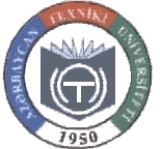
Azerbaijan Technical University
Encyclopedia
Azerbaijan Technical University (AzTU; ) is a public university
, specialized in engineering
, located in Baku
, Azerbaijan
. The University has 9 schools and 54 departments, 884 faculty members and approximately 6500 students.
The University traces its history to the much older Baku Polytechnical Institute. On November 14, 1920, the Soviet government decreed that the previous technical school, Baku Polytechnicum
, would close and be replaced by Baku Polytechnical Institute, a more traditional polytechnic institute. The new school focused on training engineers in a broad range of industries: agriculture, civil engineering, electromechanical, economics and oil. The new school went through many name changes over the years as its emphasis changed to meet the needs of Azerbaijan. In 1923 the school changed its name to Azerbaijan Polytechnical Institute. In March 1929, the Azerbaijan Communist Party decreed that the school be split into three independent schools covering agriculture, economics and oil.
However, the expanding needs engineers in other areas outside oil resulted in expansion in the school's curriculum and the school changed names again in 1934, this time to the Azerbaijan Industrial Institute (Az. I.I.) as it was merged with civil engineering. World War II
taxed the Soviet Union and schools like Az. I.I. struggled to stay open. At the end of the War, there was great demand for oil engineers in the Soviet Union and the school trained them in great numbers. In 1950, the government founded a separate Azerbaijan Polytechnical Institute (Az. P.I.) and moved non-petrochemical curricula to the new school so that Az. I.I. could focus on the oil industry (Az. I.I. went on to eventually become the Azerbaijan State Oil Academy). In 1970, a branch of AzPI was founded in Ganja
. In 1993, AzPI changed status and became Azerbaijan Technical University.
Public university
A public university is a university that is predominantly funded by public means through a national or subnational government, as opposed to private universities. A national university may or may not be considered a public university, depending on regions...
, specialized in engineering
Institute of technology
Institute of technology is a designation employed in a wide range of learning institutions awarding different types of degrees and operating often at variable levels of the educational system...
, located in Baku
Baku
Baku , sometimes spelled as Baki or Bakou, is the capital and largest city of Azerbaijan, as well as the largest city on the Caspian Sea and of the Caucasus region. It is located on the southern shore of the Absheron Peninsula, which projects into the Caspian Sea. The city consists of two principal...
, Azerbaijan
Azerbaijan
Azerbaijan , officially the Republic of Azerbaijan is the largest country in the Caucasus region of Eurasia. Located at the crossroads of Western Asia and Eastern Europe, it is bounded by the Caspian Sea to the east, Russia to the north, Georgia to the northwest, Armenia to the west, and Iran to...
. The University has 9 schools and 54 departments, 884 faculty members and approximately 6500 students.
The University traces its history to the much older Baku Polytechnical Institute. On November 14, 1920, the Soviet government decreed that the previous technical school, Baku Polytechnicum
Baku Polytechnicum
Baku Polytechnicum is a defunct technical school that was established in 1887 in Baku, when it was under Russian rule. By 1910 it had integrated a curriculum related to the growing petroleum industry. However, the ratio of Azeris to non-Azeris was so skewed that of the 494 students studying at...
, would close and be replaced by Baku Polytechnical Institute, a more traditional polytechnic institute. The new school focused on training engineers in a broad range of industries: agriculture, civil engineering, electromechanical, economics and oil. The new school went through many name changes over the years as its emphasis changed to meet the needs of Azerbaijan. In 1923 the school changed its name to Azerbaijan Polytechnical Institute. In March 1929, the Azerbaijan Communist Party decreed that the school be split into three independent schools covering agriculture, economics and oil.
However, the expanding needs engineers in other areas outside oil resulted in expansion in the school's curriculum and the school changed names again in 1934, this time to the Azerbaijan Industrial Institute (Az. I.I.) as it was merged with civil engineering. World War II
World War II
World War II, or the Second World War , was a global conflict lasting from 1939 to 1945, involving most of the world's nations—including all of the great powers—eventually forming two opposing military alliances: the Allies and the Axis...
taxed the Soviet Union and schools like Az. I.I. struggled to stay open. At the end of the War, there was great demand for oil engineers in the Soviet Union and the school trained them in great numbers. In 1950, the government founded a separate Azerbaijan Polytechnical Institute (Az. P.I.) and moved non-petrochemical curricula to the new school so that Az. I.I. could focus on the oil industry (Az. I.I. went on to eventually become the Azerbaijan State Oil Academy). In 1970, a branch of AzPI was founded in Ganja
Ganja, Azerbaijan
Ganja is Azerbaijan's second-largest city with a population of around 313,300. It was named Yelizavetpol in the Russian Empire period. The city regained its original name—Ganja—from 1920–1935 during the first part of its incorporation into the Soviet Union. However, its name was changed again and...
. In 1993, AzPI changed status and became Azerbaijan Technical University.

